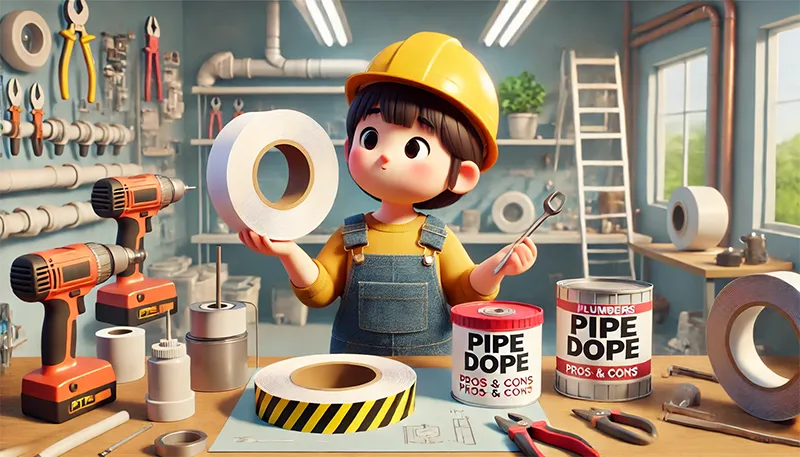When it comes to ensuring leak-free plumbing connections, one decision can make all the difference: PTFE tape or pipe dope? Both are popular thread sealants, but their differences can leave even experienced DIYers scratching their heads.
Choosing the right sealant depends on your project’s specific needs—whether it’s a quick household repair or a heavy-duty industrial job.
In this guide, we’ll dive into PTFE tape vs pipe dope, helping you decide which one is the best fit for your plumbing tasks.
What Are PTFE Tape and Pipe Dope?
- PTFE Tape (Thread Seal Tape)
PTFE tape, commonly known as Teflon tape, is a thin, non-sticky film designed for sealing threaded pipe connections. It’s lightweight, easy to use, and ideal for preventing leaks in water, air, and gas systems. Its simplicity makes it a go-to for DIY repairs. - Pipe Dope (Thread Sealant)
Pipe dope, on the other hand, is a paste-like compound that seals and lubricates threaded connections. It’s applied using a brush or tool and creates a durable bond. Pipe dope is often used in heavy-duty plumbing tasks and is prized for its versatility across various pipe materials.
Key Differences Between PTFE Tape and Pipe Dope
Material: PTFE tape is a thin film, while pipe dope is a thick paste.
Application: PTFE tape is wrapped around the threads, while pipe dope is brushed on.
Compatibility: PTFE tape works well for most water and gas pipes; pipe dope excels with metal and plastic fittings in industrial settings.
Cleanliness: PTFE tape is mess-free; pipe dope can be sticky and harder to clean up.
These distinctions make each sealant better suited for specific applications.
Pros and Cons of PTFE Tape
Pros
- Easy to Apply: Wrapping PTFE tape around threads is quick and straightforward.
- Clean and Convenient: There’s no sticky residue, making it ideal for DIY projects.
- Versatile: Works well with water, air, and low-pressure gas lines.
Cons
- Limited Durability: Not ideal for high-pressure or heavy-duty systems.
- Requires Precision: Improper application can lead to leaks or tape unraveling.
- Single Use: The tape cannot be reused once a connection is undone.
Pros and Cons of Pipe Dope
Pros
- Durable Seal: Creates a strong, long-lasting bond that resists leaks.
- High-Pressure Ready: Handles industrial-grade applications and extreme conditions.
- Temperature Resistant: Performs well under temperature fluctuations and vibrations.
Cons
- Messy Application: It’s easy to overapply, leading to sticky residue.
- Hardens Over Time: Some formulations can become brittle, making removal difficult.
- Not Always Plastic-Friendly: Must be checked for compatibility with plastic pipes.
When to Use PTFE Tape vs. Pipe Dope
PTFE Tape: Best for small, low-pressure connections and DIY projects. Perfect for water and air pipes, and for quick fixes like sealing a leaky faucet or a shower head.
Pipe Dope: Ideal for professional-grade plumbing, high-pressure systems, and industrial environments. It’s the go-to for HVAC systems, gas pipelines, and heavy-duty repairs.
Example Scenarios:
- PTFE Tape: Fixing a sink drain connection or sealing garden hose fittings.
- Pipe Dope: Securing large-diameter pipes in a boiler system or gas line connections.
Tips for Effective Use of PTFE Tape and Pipe Dope
Using PTFE Tape:
- Wrap the tape clockwise around the threads 2-4 times.
- Ensure the tape covers the threads completely but doesn’t overlap excessively.
- Smooth it down to ensure a snug fit.
Using Pipe Dope:
- Apply evenly using a brush or applicator, covering all threads.
- Avoid over-applying; a thin, consistent layer works best.
- Tighten the connection carefully to prevent over-torquing.
FAQs
-
Can I use PTFE tape and pipe dope together?
Yes, in some cases, combining both can offer extra sealing strength. However, this is rarely necessary and may complicate disassembly later.
-
Which is better for gas lines: PTFE tape or pipe dope?
Gas-rated PTFE tape (yellow tape) is commonly used. Pipe dope is also effective but must be specifically rated for gas systems.
-
Is PTFE tape reusable?
No, PTFE tape should be replaced whenever a fitting is undone to ensure a proper seal.
-
Does pipe dope harden over time?
Yes, some formulations can harden, especially in high-temperature applications, making future adjustments challenging.
-
Can pipe dope be used on plastic pipes?
Yes, but only with pipe dope specifically labeled as safe for plastic materials.
PTFE Tape vs Pipe Dope: Whose The Winner?
The debate between PTFE tape and pipe dope boils down to application and preference. PTFE tape shines in quick, low-pressure fixes, while pipe dope excels in heavy-duty and professional settings. Understanding their strengths and limitations ensures you’ll always have the right tool for the job.
Keep both handy in your toolkit, and you’ll be ready for any plumbing challenge that comes your way!



